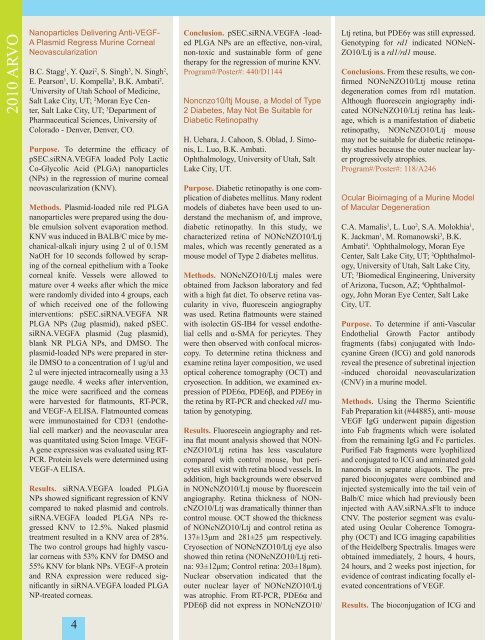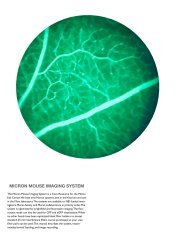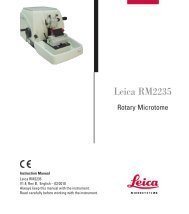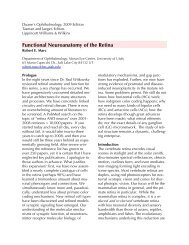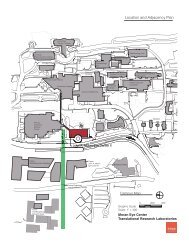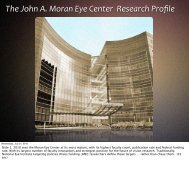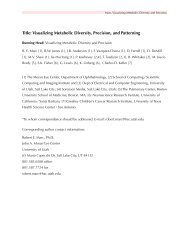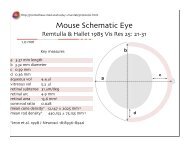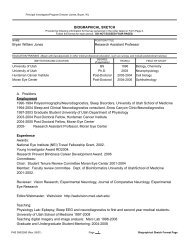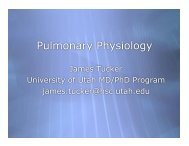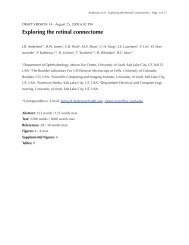this download - University of Utah
this download - University of Utah
this download - University of Utah
You also want an ePaper? Increase the reach of your titles
YUMPU automatically turns print PDFs into web optimized ePapers that Google loves.
2010 ARVO<br />
Nanoparticles Delivering Anti-VEGF-<br />
A Plasmid Regress Murine Corneal<br />
Neovascularization<br />
B.C. Stagg 1 , Y. Qazi 2 , S. Singh 3 , N. Singh 2 ,<br />
E. Pearson 1 , U. Kompella 3 , B.K. Ambati 2 .<br />
1 <strong>University</strong> <strong>of</strong> <strong>Utah</strong> School <strong>of</strong> Medicine,<br />
Salt Lake City, UT; 2 Moran Eye Center,<br />
Salt Lake City, UT; 3 Department <strong>of</strong><br />
Pharmaceutical Sciences, <strong>University</strong> <strong>of</strong><br />
Colorado - Denver, Denver, CO.<br />
Purpose. To determine the efficacy <strong>of</strong><br />
pSEC.siRNA.VEGFA loaded Poly Lactic<br />
Co-Glycolic Acid (PLGA) nanoparticles<br />
(NPs) in the regression <strong>of</strong> murine corneal<br />
neovascularization (KNV).<br />
Methods. Plasmid-loaded nile red PLGA<br />
nanoparticles were prepared using the double<br />
emulsion solvent evaporation method.<br />
KNV was induced in BALB/C mice by mechanical-alkali<br />
injury using 2 ul <strong>of</strong> 0.15M<br />
NaOH for 10 seconds followed by scraping<br />
<strong>of</strong> the corneal epithelium with a Tooke<br />
corneal knife. Vessels were allowed to<br />
mature over 4 weeks after which the mice<br />
were randomly divided into 4 groups, each<br />
<strong>of</strong> which received one <strong>of</strong> the following<br />
interventions: pSEC.siRNA.VEGFA NR<br />
PLGA NPs (2ug plasmid), naked pSEC.<br />
siRNA.VEGFA plasmid (2ug plasmid),<br />
blank NR PLGA NPs, and DMSO. The<br />
plasmid-loaded NPs were prepared in sterile<br />
DMSO to a concentration <strong>of</strong> 1 ug/ul and<br />
2 ul were injected intracorneally using a 33<br />
gauge needle. 4 weeks after intervention,<br />
the mice were sacrificed and the corneas<br />
were harvested for flatmounts, RT-PCR,<br />
and VEGF-A ELISA. Flatmounted corneas<br />
were immunostained for CD31 (endothelial<br />
cell marker) and the neovascular area<br />
was quantitated using Scion Image. VEGF-<br />
A gene expression was evaluated using RT-<br />
PCR. Protein levels were determined using<br />
VEGF-A ELISA.<br />
Results. siRNA.VEGFA loaded PLGA<br />
NPs showed significant regression <strong>of</strong> KNV<br />
compared to naked plasmid and controls.<br />
siRNA.VEGFA loaded PLGA NPs regressed<br />
KNV to 12.5%. Naked plasmid<br />
treatment resulted in a KNV area <strong>of</strong> 28%.<br />
The two control groups had highly vascular<br />
corneas with 53% KNV for DMSO and<br />
55% KNV for blank NPs. VEGF-A protein<br />
and RNA expression were reduced significantly<br />
in siRNA.VEGFA loaded PLGA<br />
NP-treated corneas.<br />
4<br />
Conclusion. pSEC.siRNA.VEGFA -loaded<br />
PLGA NPs are an effective, non-viral,<br />
non-toxic and sustainable form <strong>of</strong> gene<br />
therapy for the regression <strong>of</strong> murine KNV.<br />
Program#/Poster#: 440/D1144<br />
Noncnzo10/ltj Mouse, a Model <strong>of</strong> Type<br />
2 Diabetes, May Not Be Suitable for<br />
Diabetic Retinopathy<br />
H. Uehara, J. Cahoon, S. Oblad, J. Simonis,<br />
L. Luo, B.K. Ambati.<br />
Ophthalmology, <strong>University</strong> <strong>of</strong> <strong>Utah</strong>, Salt<br />
Lake City, UT.<br />
Purpose. Diabetic retinopathy is one complication<br />
<strong>of</strong> diabetes mellitus. Many rodent<br />
models <strong>of</strong> diabetes have been used to understand<br />
the mechanism <strong>of</strong>, and improve,<br />
diabetic retinopathy. In <strong>this</strong> study, we<br />
characterized retina <strong>of</strong> NONcNZO10/Ltj<br />
males, which was recently generated as a<br />
mouse model <strong>of</strong> Type 2 diabetes mellitus.<br />
Methods. NONcNZO10/Ltj males were<br />
obtained from Jackson laboratory and fed<br />
with a high fat diet. To observe retina vascularity<br />
in vivo, fluorescein angiography<br />
was used. Retina flatmounts were stained<br />
with isolectin GS-IB4 for vessel endothelial<br />
cells and α-SMA for pericytes. They<br />
were then observed with confocal microscopy.<br />
To determine retina thickness and<br />
examine retina layer composition, we used<br />
optical coherence tomography (OCT) and<br />
cryosection. In addition, we examined expression<br />
<strong>of</strong> PDE6α, PDE6β, and PDE6γ in<br />
the retina by RT-PCR and checked rd1 mutation<br />
by genotyping.<br />
Results. Fluorescein angiography and retina<br />
flat mount analysis showed that NONcNZO10/Ltj<br />
retina has less vasculature<br />
compared with control mouse, but pericytes<br />
still exist with retina blood vessels. In<br />
addition, high backgrounds were observed<br />
in NONcNZO10/Ltj mouse by fluorescein<br />
angiography. Retina thickness <strong>of</strong> NONcNZO10/Ltj<br />
was dramatically thinner than<br />
control mouse. OCT showed the thickness<br />
<strong>of</strong> NONcNZO10/Ltj and control retina as<br />
137±13μm and 281±25 μm respectively.<br />
Cryosection <strong>of</strong> NONcNZO10/Ltj eye also<br />
showed thin retina (NONcNZO10/Ltj retina:<br />
93±12μm; Control retina: 203±18μm).<br />
Nuclear observation indicated that the<br />
outer nuclear layer <strong>of</strong> NONcNZO10/Ltj<br />
was atrophic. From RT-PCR, PDE6α and<br />
PDE6β did not express in NONcNZO10/<br />
Ltj retina, but PDE6γ was still expressed.<br />
Genotyping for rd1 indicated NONcN-<br />
ZO10/Ltj is a rd1/rd1 mouse.<br />
Conclusions. From these results, we confirmed<br />
NONcNZO10/Ltj mouse retina<br />
degeneration comes from rd1 mutation.<br />
Although fluorescein angiography indicated<br />
NONcNZO10/Ltj retina has leakage,<br />
which is a manifestation <strong>of</strong> diabetic<br />
retinopathy, NONcNZO10/Ltj mouse<br />
may not be suitable for diabetic retinopathy<br />
studies because the outer nuclear layer<br />
progressively atrophies.<br />
Program#/Poster#: 118/A246<br />
Ocular Bioimaging <strong>of</strong> a Murine Model<br />
<strong>of</strong> Macular Degeneration<br />
C.A. Mamalis 1 , L. Luo 2 , S.A. Molokhia 1 ,<br />
K. Jackman 1 , M. Romanowski 3 , B.K.<br />
Ambati 4 . 1 Ophthalmology, Moran Eye<br />
Center, Salt Lake City, UT; 2 Ophthalmology,<br />
<strong>University</strong> <strong>of</strong> <strong>Utah</strong>, Salt Lake City,<br />
UT; 3 Biomedical Engineering, <strong>University</strong><br />
<strong>of</strong> Arizona, Tucson, AZ; 4 Ophthalmology,<br />
John Moran Eye Center, Salt Lake<br />
City, UT.<br />
Purpose. To determine if anti-Vascular<br />
Endothelial Growth Factor antibody<br />
fragments (fabs) conjugated with Indocyanine<br />
Green (ICG) and gold nanorods<br />
reveal the presence <strong>of</strong> subretinal injection<br />
-induced choroidal neovascularization<br />
(CNV) in a murine model.<br />
Methods. Using the Thermo Scientific<br />
Fab Preparation kit (#44885), anti- mouse<br />
VEGF IgG underwent papain digestion<br />
into Fab fragments which were isolated<br />
from the remaining IgG and Fc particles.<br />
Purified Fab fragments were lyophilized<br />
and conjugated to ICG and aminated gold<br />
nanorods in separate aliquots. The prepared<br />
bioconjugates were combined and<br />
injected systemically into the tail vein <strong>of</strong><br />
Balb/C mice which had previously been<br />
injected with AAV.siRNA.sFlt to induce<br />
CNV. The posterior segment was evaluated<br />
using Ocular Coherence Tomography<br />
(OCT) and ICG imaging capabilities<br />
<strong>of</strong> the Heidelberg Spectralis. Images were<br />
obtained immediately, 2 hours, 4 hours,<br />
24 hours, and 2 weeks post injection, for<br />
evidence <strong>of</strong> contrast indicating focally elevated<br />
concentrations <strong>of</strong> VEGF.<br />
Results. The bioconjugation <strong>of</strong> ICG and


